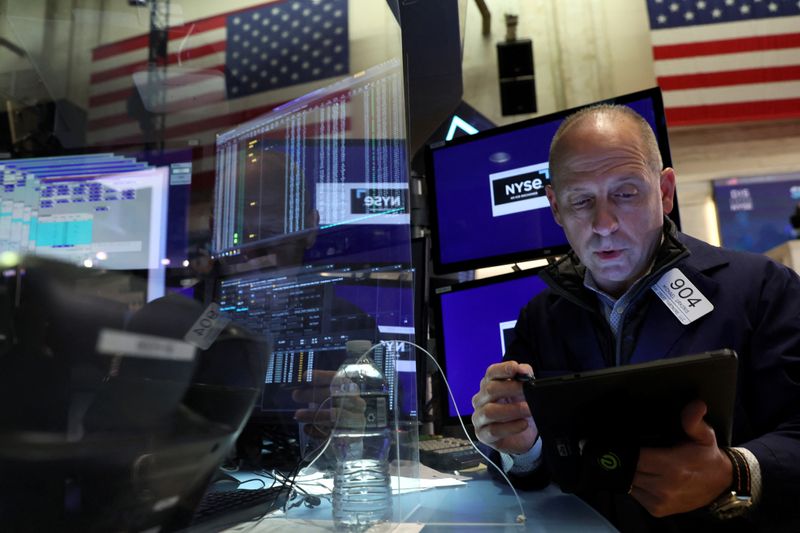
1. Futures edge up
US stock futures pointed higher on Tuesday, after comments from Fed officials regarding the jumbo rate cut drove up equities on Wall Street in the prior session.
By 03:22 ET (07:22 GMT), the Dow futures contract had added 37 points or 0.1%, S&P 500 futures had inched up by 8 points or 0.1%, and Nasdaq 100 futures had gained 47 points or 0.2%.
The 30-stock Dow Jones Industrial Average, benchmark S&P 500 and tech-heavy Nasdaq Composite all gained on Monday, as investors assessed statements in support of the Fed’s outsized 50-basis point rate reduction last week. Fed officials including Neel Kashkari, Raphael Bostic, and Austan Goolsbee all backed the move and argued for further slashes to borrowing costs this year.
Meanwhile, new data showed that US business activity held steady in September and average prices for goods and services climbed at the fastest pace in half a year. The figures, along with the release of the latest personal consumption expenditures (PCE) price index — one of the Fed’s preferred inflation gauges, could provide an updated glimpse into the state of price growth in the world’s biggest economy.
Traders are now betting that there is a roughly 53% chance the Fed will bring rates down by a half-point again at its next meeting in November, according to the CME Group’s (NASDAQ:CME) closely-monitored FedWatch Tool.
2. Fed’s Bowman to speak
Markets will likely be following comments on Tuesday from Fed Governor — and sole dissenter to the size of last week’s rate cut — Michelle Bowman.
Bowman is due to speak at 09:00 ET at the Kentucky Bankers Association Annual Convention, according to the Fed.
The statements will come after Bowman said last week that she had favored a quarter-point drawdown due to concerns that a bigger reduction would be misinterpreted by the public as a sign that the Fed’s long-standing fight against inflation had been won.
In particular, she noted that so-called “core” PCE, which strips out volatile items like food and fuel, currently stands above the central bank’s preferred 2% target.
“We have not yet achieved our inflation goal,” Bowman said on Friday, adding a more measured rate cut would “avoid unnecessarily stoking demand.”
3. Boeing puts improved pay offer to striking workers
Boeing has offered a sweetened labor deal to its more than 30,000 striking workers in the US Pacific Northwest, although their union has said it would not put the proposal to a vote.
The aerospace giant’s latest offer includes a 30% general pay bump over four years as well as improvement in retirement benefits and an increased ratification bonus if the workers accept the proposal by Friday. Boeing said it was its “best and final” offer.
However, the International Association of Machinists and Aerospace Workers District 751, which represents the workers, rebuffed the approach, saying it was “thrown at us” by Boeing without prior negotiations. The company, meanwhile, said it had presented the offer to the union and then to the employees.
Finding a resolution to the strike, which began after workers rejected a prior compensation package earlier this month, has become critical for Boeing. Analysts have flagged that a prolonged work stoppage could place a further crimp on the firm’s finances during a time when it is already facing production delays and heightened scrutiny over its safety record.
4. Chinese stocks surge on stimulus
China’s Shanghai Shenzhen CSI 300 and Shanghai Composite indices rose more than 4% on Tuesday, while Hong Kong’s Hang Seng index also rallied, following fresh stimulus measures from Beijing.
Chinese officials unveiled a slew of planned measures to further spur economic growth, with the People’s Bank of China (PBOC) set to cut reserve requirements for banks by 50 basis points to unlock more liquidity.
For the ailing property market, the government said it would reduce mortgage rates for existing loans. Bloomberg reported that the government was planning at least 500 billion yuan ($70.8 billion) of liquidity support for local stocks.
The moves come after the PBOC cut a short-term repo rate on Monday in a bid to further boost liquidity. Officials in China are pushing to shore up growth as the world’s second-largest economy struggles with persistent disinflation and an extended property market downturn.
5. Crude rises
Crude prices advanced on Tuesday, boosted by the monetary stimulus from top importer China as well as escalating tensions in the Middle East.
By 03:23 ET, the Brent contract climbed 1.2% to $74.08 per barrel, while U.S. crude futures (WTI) traded 1.4% higher at $71.34 a barrel.
China’s broad stimulus measures boosted hopes of expanding demand for crude from the world’s largest importer.
Elsewhere, Israel’s military said it launched airstrikes against Hezbollah sites in Lebanon on Monday, raising concerns of a disruption to supplies from this oil-rich region, tightening global markets.
To read the full article, Click Here
